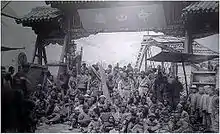
The Chinese famine of 1928–1930 occurred as widespread drought hit Northwestern and Northern China, most notably in the provinces of Henan, Shaanxi and Gansu.[1] Mortality is estimated to be within 6 million, which already included deaths from famine-led diseases.[2] The inefficiency of relief has been pointed out as a factor which aggravated the famine.[3][4]
Historical background
From 1928 to 1930, China was under the control of Chiang's the Nanjing Nationalist government.
The Nanjing Nationalist government was established in April 1927, a year after the Northern Expedition war ended, this war ended the power of imperialism in China, and it is a war that the Chinese Communist Party (CCP)collaborated with the Chinese Nationalist Party (CNP). After the Northern Expedition ended, Chiang, as the leader of CNP, breached the collaboration between the two parties, Chiang began to arrest and murder the members of CCP. This event is called Shanghai massacre or the April 12 Purge or April 12 Incident. In the same year, the Nanjing Nationalist government had established. The CCP retreated to the countryside and hid. Chiang kept murdering the CCP.[5]
When the famine happened, the Nanjing Nationalist government was still focusing on persecuting the CCP. At that time, the leader of the Northwestern army, Yuxiang Feng, did not agree with Chiang’s policies against the CCP, therefore, he was preparing for a war against Chiang’s domination. This war came to be known as the Central Plains war.[6]
Consequence
Death by famine
When famine developed more, people began to eat everything they could eat, including bark, grass rooter, tree leaves, bran, mud and animals they fed. After people had eaten everything they can eat. Human cannibalism also occurred; people exchanged their new children to eat. Many dead bodies had no feet or arms, people even thought that: if they did not eat their own children or parents’ bodies, other people won eat their bodies also.[7]
Some people would die from eating too much mud. The mud that they ate is Kaolinite, it is also called Guanyin Mud in Chinese (Chinese:观音土). This kind of mud can give the human body a false appearance of full, it completely cannot be absorbed or digested by the human body. After the false appearance of full faded, people ate again, eventually, people would die from cannot excrete the mud to the outside of their body.[8]
Death by violence
At the preliminary stage of the famine, the price of crops began to increase. Some grabbing food events had occurred. In 1927, some robbing events had been reported, this part of people who robbed was called “brigand” by the government at that time. A part of them were broken farmers, they robbed food from rich landlords; a part of them were beggars; the rest of them were some local armies, and they had guns.[9]
Besides, the Central Plains war maybe another reason that caused death.
Death by plague
Many people also died because of plague, many people died because of suicide or staving, their dead body had not been buried. All died bodies were thrown into a big hole, human bodies and animal bodies mixed. The reason why these bodies could not be buried is because surrounding villages kept throwing bodies into this big hole.[9] In addition, some people would dig the graves, for eating new dead body or money. In ancient Chinese culture, when a person died, their children would also bury something they used like with them. Usually, there would be some potteries, in rich people’s grave, there would be some gold, silver and jewelry. Some people would dig rich people’s grave for these valuables. Bodies that could not be buried and bodies that were dug out produced the plague.[7]
Death toll
Gansu's population in 1922 was 6,403,339,[10] before the famine struck in 1928 its population likely reached 7 million. Of which, an estimate of 2.5-3.0 million of Gansu people died.[2] Shaanxi's population in 1928 was 11,802,446,[10] an estimate of 3 million died. In total 6 million died.[2] Some put the mortality as high as 10 million.[11][12]
See also
References
- ↑ Li, Yucai (2006). 冯玉祥与民国年间豫陕甘大赈灾(1928-1930) [Feng Yu-xiang's Relief Work of Drought in Henan, Shaanxi and Gansu Provinces During Min Guo Period (1928-1930)]. Zhōngguó Nóngshǐ 中国农史 [Agricultural History of China] (in Chinese). 25 (1): 73–81. ISSN 1000-4459. Archived from the original on 2011-07-13. Retrieved 2011-02-15.
- 1 2 3 Li, Lillian M. (2007). Fighting Famine in North China: State, Market, and Environmental Decline, 1690s–1990s (PDF). Stanford: Stanford University Press. pp. 303–307. Archived from the original (PDF) on 2021-12-27.
In Gansu the estimated mortality was 2.5 to 3 million [...] In Shaanxi, out of a population of 13 million, an estimated 3 million died of hunger or disease
- ↑ Chen, Sherong (2002). 浅析1928-1930年西北大旱灾的特点及影响 [An Elementary Study about the Characteristics and the Effect of the Great Drought in Northwest China from 1928 to 1930]. Gùyuán Shīzhuān Xuébào 固原师专学报 [Journal of Guyuan Teachers College] (in Chinese). 23 (1). Archived from the original on 2011-07-07. Retrieved 2011-02-15.
- ↑ "话说民国十八年(1928)的大饥荒". Zhōngguó Qīngnián Wǎng 中国青年网 (in Chinese). 28 November 2014. Archived from the original on 2017-08-02. Retrieved 2017-08-02.
- ↑ alphahis (2013-05-22). "The Shanghai Massacre". Chinese Revolution. Retrieved 2023-11-27.
- ↑ Worthing, Peter (November 2018). "A Tale of Two Fronts: China's War of the Central Plains, 1930". War in History. 25 (4): 511–533. doi:10.1177/0968344516685927. ISSN 0968-3445.
- 1 2 安, 少梅 (2010). 陕西民国十八年年馑研究 (硕士 thesis). 西北大学.
- ↑ 陈, 生伟 (2019). 1928-1929年山西旱灾及救济研究 (硕士 thesis). 湖南师范大学.
- 1 2 宗, 鸣安 (2009). "一场饿死二百万人的大灾荒——陕西"民国十八年年馑"史实汇录". 中国减灾: 51–52 – via CNKI.
{{cite journal}}: Check|url=value (help) - 1 2 侯杨方 (2001). 中国人口史 第六卷: 1910-1953年. 复旦大学出版社. pp. 129, 134.
- ↑ Li, Lilian (2007). Fighting Famine in North China: State, Market and Environmental Decline, 1690s-1990s. Stanford University Press. p. 284.
- ↑ Vernoff, E.; Seybolt, P. J. Through Chinese Eyes: Tradition, Revolution, and Transformation.